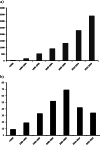Biomarkers of sepsis: time for a reappraisal
- PMID: 32503670
- PMCID: PMC7273821
- DOI: 10.1186/s13054-020-02993-5
Biomarkers of sepsis: time for a reappraisal
Abstract
Introduction: Sepsis biomarkers can have important diagnostic, therapeutic, and prognostic functions. In a previous review, we identified 3370 references reporting on 178 different biomarkers related to sepsis. In the present review, we evaluate the progress in the research of sepsis biomarkers.
Methods: Using the same methodology as in our previous review, we searched the PubMed database from 2009 until September 2019 using the terms "Biomarker" AND "Sepsis." There were no restrictions by age or language, and all studies, clinical and experimental, were included.
Results: We retrieved a total of 5367 new references since our previous review. We identified 258 biomarkers, 80 of which were new compared to our previous list. The majority of biomarkers have been evaluated in fewer than 5 studies, with 81 (31%) being assessed in just a single study. Apart from studies of C-reactive protein (CRP) or procalcitonin (PCT), only 26 biomarkers have been assessed in clinical studies with more than 300 participants. Forty biomarkers have been compared to PCT and/or CRP for their diagnostic value; 9 were shown to have a better diagnostic value for sepsis than either or both of these biomarkers. Forty-four biomarkers have been evaluated for a role in answering a specific clinical question rather than for their general diagnostic or prognostic properties in sepsis.
Conclusions: The number of biomarkers being identified is still increasing although at a slower rate than in the past. Most of the biomarkers have not been well-studied; in particular, the clinical role of these biomarkers needs to be better evaluated.
Keywords: C-reactive protein; Diagnosis; Infection; Procalcitonin; Prognosis; Validation.
Conflict of interest statement
JLV is the Editor-in-Chief of
The other authors declare that they have no relevant financial interests.
Figures
Similar articles
-
The efficacy of procalcitonin as a biomarker in the management of sepsis: slaying dragons or tilting at windmills?Surg Infect (Larchmt). 2013 Dec;14(6):489-511. doi: 10.1089/sur.2012.028. Epub 2013 Nov 25. Surg Infect (Larchmt). 2013. PMID: 24274059 Review.
-
Comparison between white blood cell count, procalcitonin and C reactive protein as diagnostic and prognostic biomarkers of infection or sepsis in patients presenting to emergency department.Clin Chem Lab Med. 2014 Oct;52(10):1465-72. doi: 10.1515/cclm-2014-0210. Clin Chem Lab Med. 2014. PMID: 24803611
-
Presepsin as a diagnostic marker of sepsis in children and adolescents: a systemic review and meta-analysis.BMC Infect Dis. 2019 Aug 30;19(1):760. doi: 10.1186/s12879-019-4397-1. BMC Infect Dis. 2019. PMID: 31470804 Free PMC article.
-
The diagnostic accuracy of procalcitonin and C-reactive protein for sepsis: A systematic review and meta-analysis.J Cell Biochem. 2019 Apr;120(4):5852-5859. doi: 10.1002/jcb.27870. Epub 2018 Nov 11. J Cell Biochem. 2019. PMID: 30417415
-
The combination of procalcitonin and C-reactive protein or presepsin alone improves the accuracy of diagnosis of neonatal sepsis: a meta-analysis and systematic review.Crit Care. 2018 Nov 21;22(1):316. doi: 10.1186/s13054-018-2236-1. Crit Care. 2018. PMID: 30463590 Free PMC article.
Cited by
-
LncRNA GAS5 downregulates NLRP3 inflammasome activation-mediated pyroptosis in sepsis-induced myocardial injury by targeting SIRT3/AMPKα.Heliyon. 2023 Nov 28;9(12):e22939. doi: 10.1016/j.heliyon.2023.e22939. eCollection 2023 Dec. Heliyon. 2023. PMID: 38076153 Free PMC article.
-
Organotypic heterogeneity in microvascular endothelial cell responses in sepsis-a molecular treasure trove and pharmacological Gordian knot.Front Med (Lausanne). 2023 Nov 9;10:1252021. doi: 10.3389/fmed.2023.1252021. eCollection 2023. Front Med (Lausanne). 2023. PMID: 38020105 Free PMC article. Review.
-
Diagnostic accuracy of C-reactive protein to rule out infectious complications following hip fracture surgery.Pak J Med Sci. 2022 Jul-Aug;38(6):1514-1519. doi: 10.12669/pjms.38.6.5577. Pak J Med Sci. 2022. PMID: 35991254 Free PMC article.
-
The Potential Cost and Cost-Effectiveness Impact of Using a Machine Learning Algorithm for Early Detection of Sepsis in Intensive Care Units in Sweden.J Health Econ Outcomes Res. 2022 Apr 26;9(1):101-110. doi: 10.36469/jheor.2022.33951. eCollection 2022. J Health Econ Outcomes Res. 2022. PMID: 35620451 Free PMC article.
-
Dynamic Changes in Soluble Triggering Receptor Expressed on Myeloid Cells-1 in Sepsis with Respect to Antibiotic Susceptibility.Infect Drug Resist. 2024 May 28;17:2141-2147. doi: 10.2147/IDR.S464286. eCollection 2024. Infect Drug Resist. 2024. PMID: 38828372 Free PMC article.
References
-
- Vincent JL, Marshall JC, Namendys-Silva SA, Francois B, Martin-Loeches I, Lipman J, et al. Assessment of the worldwide burden of critical illness: the intensive care over nations (ICON) audit. Lancet Respir Med. 2014;2:380–386. - PubMed
-
- Machado FR, Cavalcanti AB, Bozza FA, Ferreira EM, Angotti Carrara FS, Sousa JL, et al. The epidemiology of sepsis in Brazilian intensive care units (the Sepsis PREvalence Assessment Database, SPREAD): an observational study. Lancet Infect Dis. 2017;17:1180–1189. - PubMed
-
- Widmann CN, Heneka MT. Long-term cerebral consequences of sepsis. Lancet Neurol. 2014;13:630–636. - PubMed
-
- Biomarkers Definitions Working Group Biomarkers and surrogate endpoints: preferred definitions and conceptual framework. Clin Pharmacol Ther. 2001;69:89–95. - PubMed
Publication types
MeSH terms
Substances
LinkOut - more resources
Full Text Sources
Other Literature Sources
Medical
Research Materials
Miscellaneous


